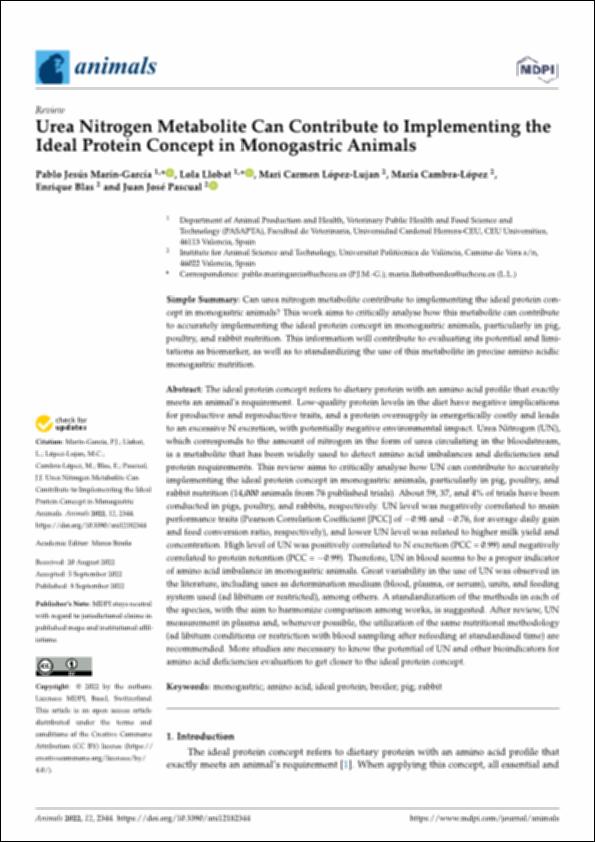Por favor, use este identificador para citar o enlazar este ítem:
http://hdl.handle.net/10637/14189Urea nitrogen metabolite can contribute to implementing the ideal protein concept in monogastric animals
| Título : | Urea nitrogen metabolite can contribute to implementing the ideal protein concept in monogastric animals |
| Autor : | Marín García, Pablo Jesús Llobat Bordes, Lola López Luján, Mari Carmen Cambra López, María Blas Ferrer, Enrique Pascual Amorós, Juan José |
| Materias: | Conejos - Alimentación - Aspectos bioquímicos.; Rabbits - Feeding and feeds - Biochemical aspects.; Proteínas.; Proteins.; Amino acids.; Urea, Ciclo de - Análisis.; Aminoácidos.; Urea cycle - Analysis. |
| Editorial : | MDPI |
| Citación : | Marín-García, P. J., Llobat, L., López-Lujan, M. C., Cambra-López, M., Blas, E. & Pascual, J. J. (2022). Urea nitrogen metabolite can contribute to implementing the ideal protein concept in monogastric animals. Animals, vol. 12, i. 18 (08 sep.), art. 2344. DOI: https://doi.org/10.3390/ani12182344 |
| Resumen : | The ideal protein concept refers to dietary protein with an amino acid profile that exactly meets an animal’s requirement. Low-quality protein levels in the diet have negative implications for productive and reproductive traits, and a protein oversupply is energetically costly and leads to an excessive N excretion, with potentially negative environmental impact. Urea Nitrogen (UN), which corresponds to the amount of nitrogen in the form of urea circulating in the bloodstream, is a metabolite that has been widely used to detect amino acid imbalances and deficiencies and protein requirements. This review aims to critically analyse how UN can contribute to accurately implementing the ideal protein concept in monogastric animals, particularly in pig, poultry, and rabbit nutrition (14,000 animals from 76 published trials). About 59, 37, and 4% of trials have been conducted in pigs, poultry, and rabbits, respectively. UN level was negatively correlated to main performance traits (Pearson Correlation Coefficient [PCC] of 0.98 and 0.76, for average daily gain and feed conversion ratio, respectively), and lower UN level was related to higher milk yield and concentration. High level of UN was positively correlated to N excretion (PCC = 0.99) and negatively correlated to protein retention (PCC = 0.99). Therefore, UN in blood seems to be a proper indicator of amino acid imbalance in monogastric animals. Great variability in the use of UN was observed in the literature, including uses as determination medium (blood, plasma, or serum), units, and feeding system used (ad libitum or restricted), among others. A standardization of the methods in each of the species, with the aim to harmonize comparison among works, is suggested. After review, UN measurement in plasma and, whenever possible, the utilization of the same nutritional methodology (ad libitum conditions or restriction with blood sampling after refeeding at standardised time) are recommended. More studies are necessary to know the potential of UN and other bioindicators for amino acid deficiencies evaluation to get closer to the ideal protein concept. |
| Descripción : | Este artículo se encuentra disponible en la siguiente URL: https://www.mdpi.com/2076-2615/12/18/2344 Este artículo pertenece al número especial "Feeding, Nutrition and Rearing Systems of the Rabbit". |
| URI : | http://hdl.handle.net/10637/14189 |
| Derechos: | http://creativecommons.org/licenses/by/4.0/deed.es |
| ISSN : | 2076-2615 (Electrónico) |
| Idioma: | es |
| Fecha de publicación : | 8-sep-2022 |
| Centro : | Universidad Cardenal Herrera-CEU |
| Aparece en las colecciones: | Dpto. Producción y Sanidad Animal, Salud Pública Veterinaria y Ciencia y Tecnología de los Alimentos |
Los ítems de DSpace están protegidos por copyright, con todos los derechos reservados, a menos que se indique lo contrario.


